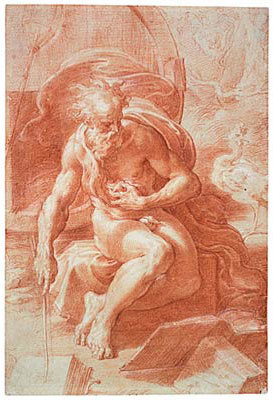 Parmigianino
Parmigianino
Supremely gifted as a painter and draftsman, Parmigianino came to Rome in 1524 seeking papal patronage but fled, as did so many of his contemporaries, when the troops of Charles V invaded the city in 1527 during the Sack of Rome. A group of five drawings from this short period are shown, including a stunning red chalk design for a print of the philosopher Diogenes, a lyrical Girl Seated on the Ground that illustrates the artist's penchant for domestic scenes, and a moving pen-and-ink Pietà freely inspired by Michelangelo's famous marble group in St. Peter's.
Antiquity
As the city was being rebuilt and reconceived under the direction of the popes, archaeological finds were commonplace, triggering a sixteenth-century fashion for antiquity that spread throughout Europe. Marble sculptures representing river gods, excavated during the 1510s and immediately put on display at the Vatican Palace, are recorded in Enea Vico's two spectacular, scrupulously detailed drawings of the early 1540s. Rome's illustrious antiquarian past informed much artistic production, as illustrated by the jewellike album on precious vellum titled The Ruins of Rome. This amusing juxtaposition of somewhat fanciful reconstructions of ancient monuments with their ruined 1570s appearance is an intriguing document of the Renaissance mind-set, bringing to life the vivid interest in reconstructing the antique.
Plan your visit. 225 Madison Avenue at 36th Street, New York, NY 10016.
Plan your visit. 225 Madison Avenue at 36th Street, New York, NY 10016.
Parmigianino and Antiquity
Parmigianino (Parma 1503–1540 Casalmaggiore) Diogenes, 1524–27 Red chalk, heightened with white chalk
